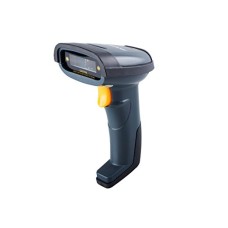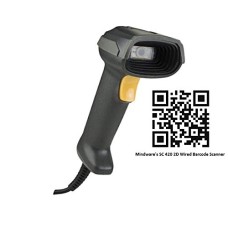What is a barcode scanner?
Barcode scanners record and translate barcodes from the image you recognize into alphanumeric digits. The scanner then sends that information along to a computer database, either through a wired connection or wirelessly (depending on the model).
Those digits refer to a particular item, and scanning the numbers and bars pulls up an entry in the database with further information such as the price, how many of this item in stock, a description of the item and possibly a picture for reference.
Barcode scanners traditionally read the barcodes most people are familiar with. These include the 1D, or linear barcode, which appears as an image of parallel lines and spaces (usually a quiet zone). A quiet zone is a space to prevent the reader from picking up other information that is not wanted or needed in the barcode scan. The blank space doesn’t send any scanning signal and so it is referred to as a quiet space (or quiet zone).
For many years, 1D barcodes were the standard, and they are still in widespread use today despite their smaller capacity for information (they can only contain about 20-25 characters, though stacking the characters helps to increase that number). 2D barcodes store information both horizontally and vertically, resulting in exponentially larger storage capacity; however, an image scanner is required to read 2D barcodes, while a simple barcode scanner can only handle linear codes.
There are different kinds of barcode scanners, some scanners use lasers, while others use lights or cameras, to capture the barcode image and turn it into an electronic code. There are pen readers, which have no moving parts, just a light source, and a photodiode to measure the lines and spaces on the 1D barcode. Laser scanners use lasers as the light source and have fewer errors scanning from a greater distance than pen readers (thanks to mirrors and lenses). CCD readers measure ambient light rather than self-reflected light and take several readings per scan to reduce errors. Camera-based readers take a photo of the barcode in order to read and decode it, and they are a decent, cheaper option. The most advanced scanner of all is the omnidirectional scanner, which is a laser scanner with more mirrors and lenses to reduce errors. An omnidirectional scanner can read ripped, crumpled or otherwise damaged barcodes at a faster rate than other, lesser laser scanners.
What are the benefits of a dedicated barcode scanner?
While there are differences among the many types of barcode readers, the benefits common to them all are what will make an investment in a dedicated scanner over a lesser solution well worth the purchase price.
A dedicated scanner:
· Integrates into your system: Barcode scanners are essentially keyboards that are connected directly to your existing systems; smartphones likely require Bluetooth adapters and/or drivers to connect to your point of sale (POS) system.
· Has few software issues: Barcode scanners don’t get viruses and don’t generally need software updates, nor are they interrupted by texts or calls from other scanners.
· Durability: Barcode scanners are built to last, operating for years without problems.
· Functionality: They can read codes quickly and read the codes from a distance, leaving behind other typical dilemmas of non-readers, like balancing battery life and slow operating systems.
A dedicated barcode reader or scanner is the best option for a business looking to integrate barcode technology into their tracking and auditing system. While mobile computers have the ability to read barcodes, they are not as stable and readable as traditional barcode scanners.
How do barcode scanners make for a more efficient business?
Barcodes have most prominently been featured in POS systems, bringing up price information at the checkout counter of a retail store, for example. Barcodes are increasingly being used in asset management, both for inventory and fixed assets, including employee information and benefits where these papers can be quickly accessed and updated as needed, just as physical items can be accessed and tracked.
Barcodes help businesses track inventory in and out of stock or production, ensures the safety of inventory from theft (by employees or otherwise), and maintains a lean turnover ratio with accuracy and elimination of excess stock. For fixed assets, barcodes can help create a comprehensive check-in/check-out system and even aid in tracking asset depreciation, maintenance, and repair. A quick scan of the barcode attached to any important item, from laptops to products, to folders with sensitive files, to safety equipment, scanners can quickly tell you everything you need to know about the item you are seeking and can update your system with the most timely information possible.
Barcode scanners come in all shapes, sizes, and forms, from pocket-fixes to handheld, fixed in one place, to wearable scanners. 1D to 2D and integrated options as part of your back-end systems or provided as an add-on to an existing mobile device. As more companies recognize the added benefits of automated asset tracking systems, expect barcodes to continue proliferating in popularity throughout the business world.
2D Barcode Symbologies
Two-dimensional (2D)
Do you know what 2D barcode symbologies are? They are two-dimensional barcodes that consist of patterned blocks, circles, and squares that resemble the no-reception static on a TV. Often physically smaller in size than linear barcodes, they contain hundreds of characters of data.
Because of their larger storage capacity, 2D barcodes—such as QR code and PDF417—do not require databases. You simply scan them to instantly access the information you need. In fact, consumers frequently scan 2D barcodes from their smartphones and tablets to access information about products. However, companies require 2D scanners to read 2D barcodes.
Two-dimensional (2D) barcodes, such as Data Matrix, PDF417, and QR Code, may have patterns of squares, dots, hexagons, and other geometric patterns. While maintaining a fairly small size, these barcode types hold much more data than linear barcodes. 2D barcodes can hold hundreds of characters.
2D Barcode features:
• Encodes/holds hundreds of characters.
• Requires a 2D barcode scanner.
• Creates a smaller barcode than 1D.
Benefits of 2D Barcodes
Because they allow for fast data access, 2D barcodes also are referred to as quick response codes. 2D barcodes also are scanned with smartphones because users easily photograph the barcode with the camera on their phone that is equipped with a barcode scanner or barcode reader app. These barcode readers interpret encoded URLs and direct users to relevant information on websites. That is why many organizations utilize 2D barcodes for mobile marketing.
Companies rely on 2D barcodes for inventory and asset tracking, especially because they can be used to import data from external sources such as databases and files. For this reason, 2D barcodes typically can be integrated easily with an existing tracking system and then used to improve it.
Businesses of all sizes benefit from barcoding systems because they enable companies to operate more efficiently. 2D barcodes and scanners reduce errors, especially when compared to manual data entry methods; by some accounts, barcode systems only result in one error for every 10,000 scans, but manual data entry results in ten errors for every 1,000 keystrokes. 2D barcodes and scanners also decrease the time spent by employees entering and changing data or tracking assets and inventory once data has been entered.
Organizations also choose 2D barcodes because they are capable of storing enough information that users do not need to refer to a database. Organizations can store all of the most pertinent information directly in the barcode, which makes 2D barcodes a top choice when tracking and auditing product batches remotely or in large facilities is a common practice.
Here, we are offering you the whole exclusive range of Barcode Scanner. Our Scanner is available in so many variants 1D, 2D and Wireless Scanners are newly introduced in this Range, which comes with high rigid performance and on a very low cost.
Online Portal - https://www.indianbarcode.in/
Official Website - https://www.indianbarcode.com/
Address
MINDWARE
S -4, Plot No-7, Pocket-7, Pankaj Plaza, Near Metro Station, Sector-12, Dwarka, New Delhi-110078, (India)
+91-11-46102688 DIRECT LINE
+91-9810822688 / +91-9717122688
Mail - gm@indianbarcode.com
Follow Us 👇
Facebook 👉 https://www.facebook.com/IndianBarcode
Twitter 👉 https://twitter.com/INDIANRFID



What an uncommon post nearly 3D printing. You especially delightfully delineated 5 steps of 3D printing. Frequently for 3D printing, you'll require a 3D scanner. In the event that you'd just like the finest 3D laser scanner at that point, you will be able to visit Best 3d modeling services Denver, Colorado
ReplyDelete